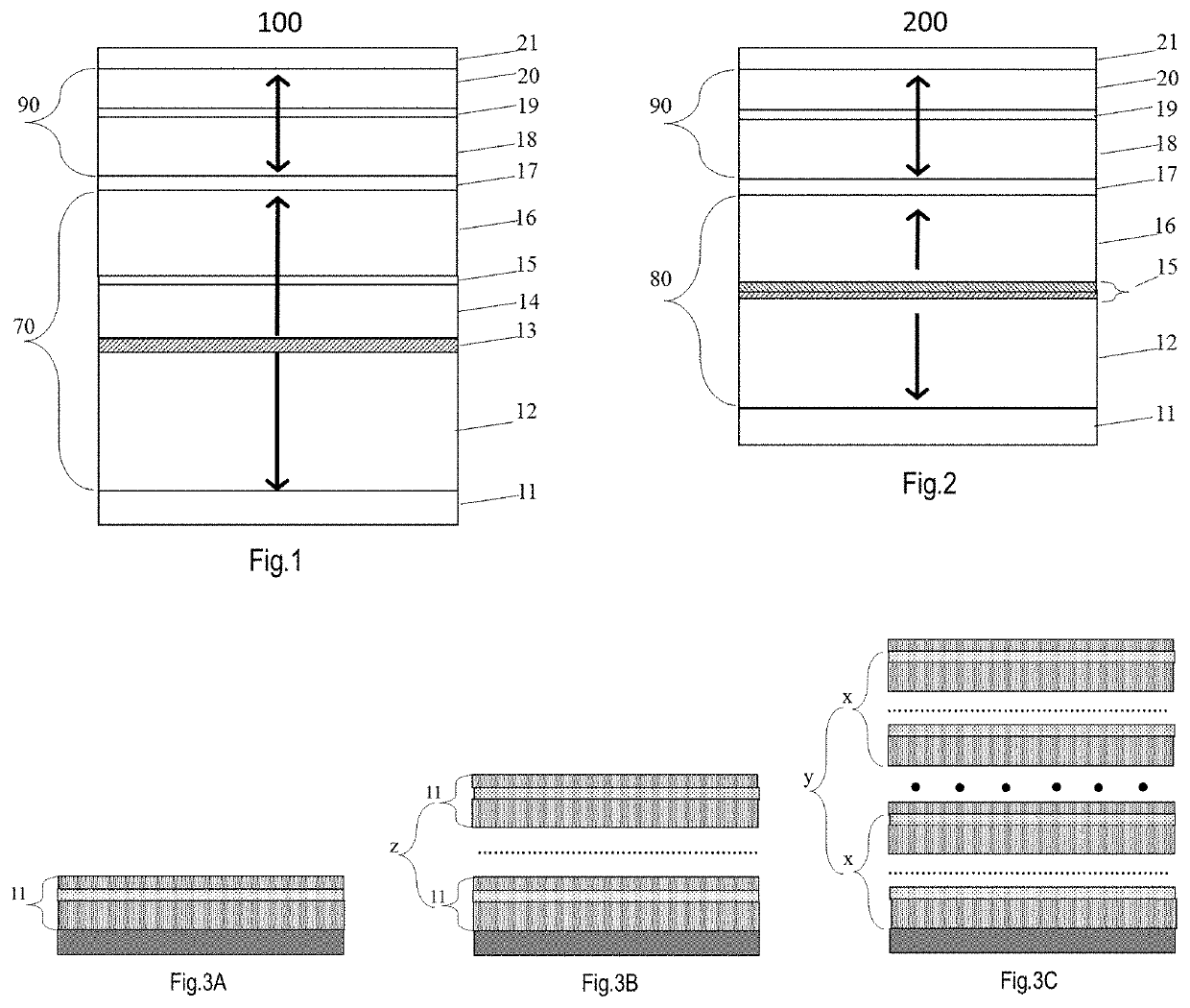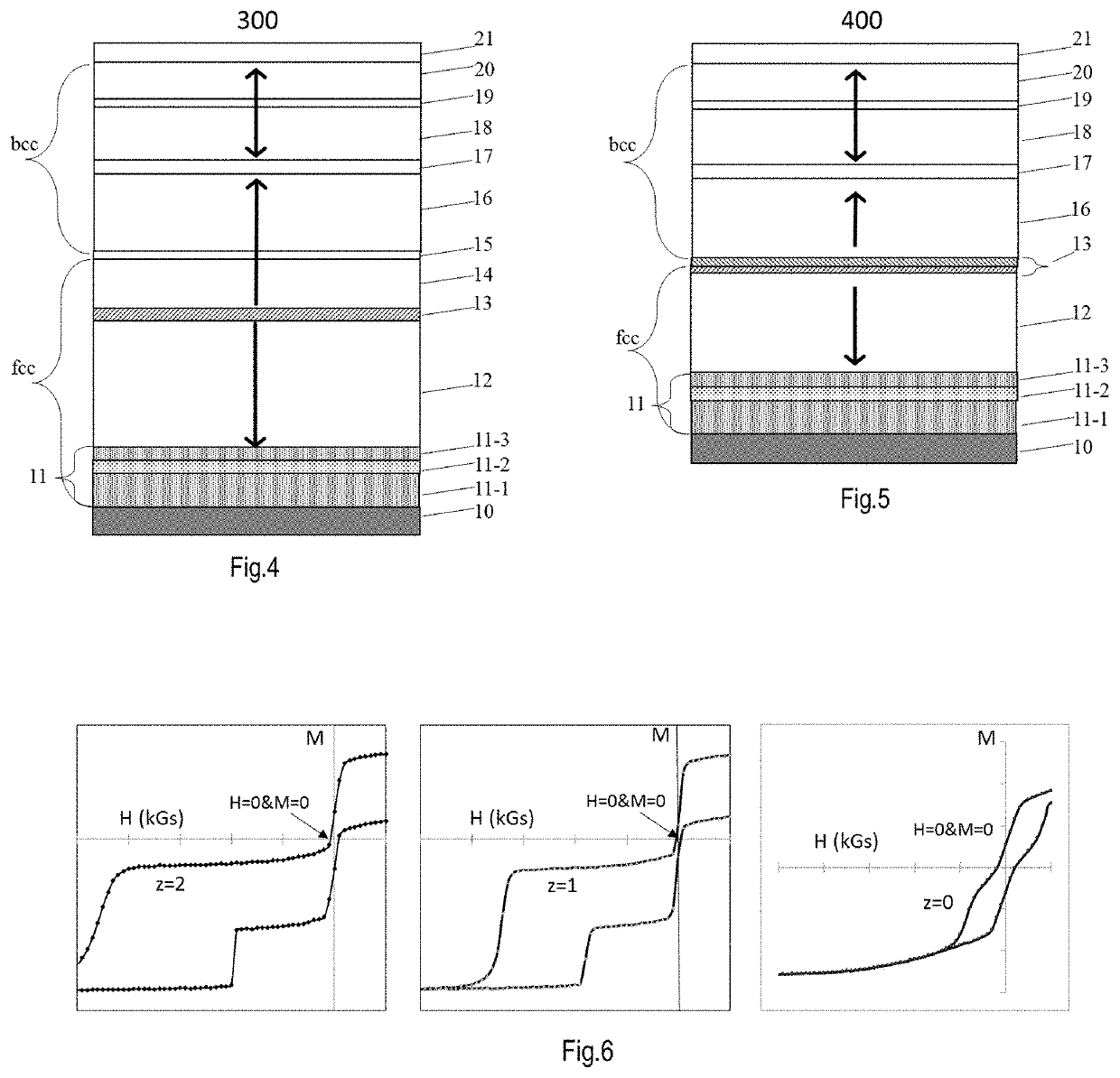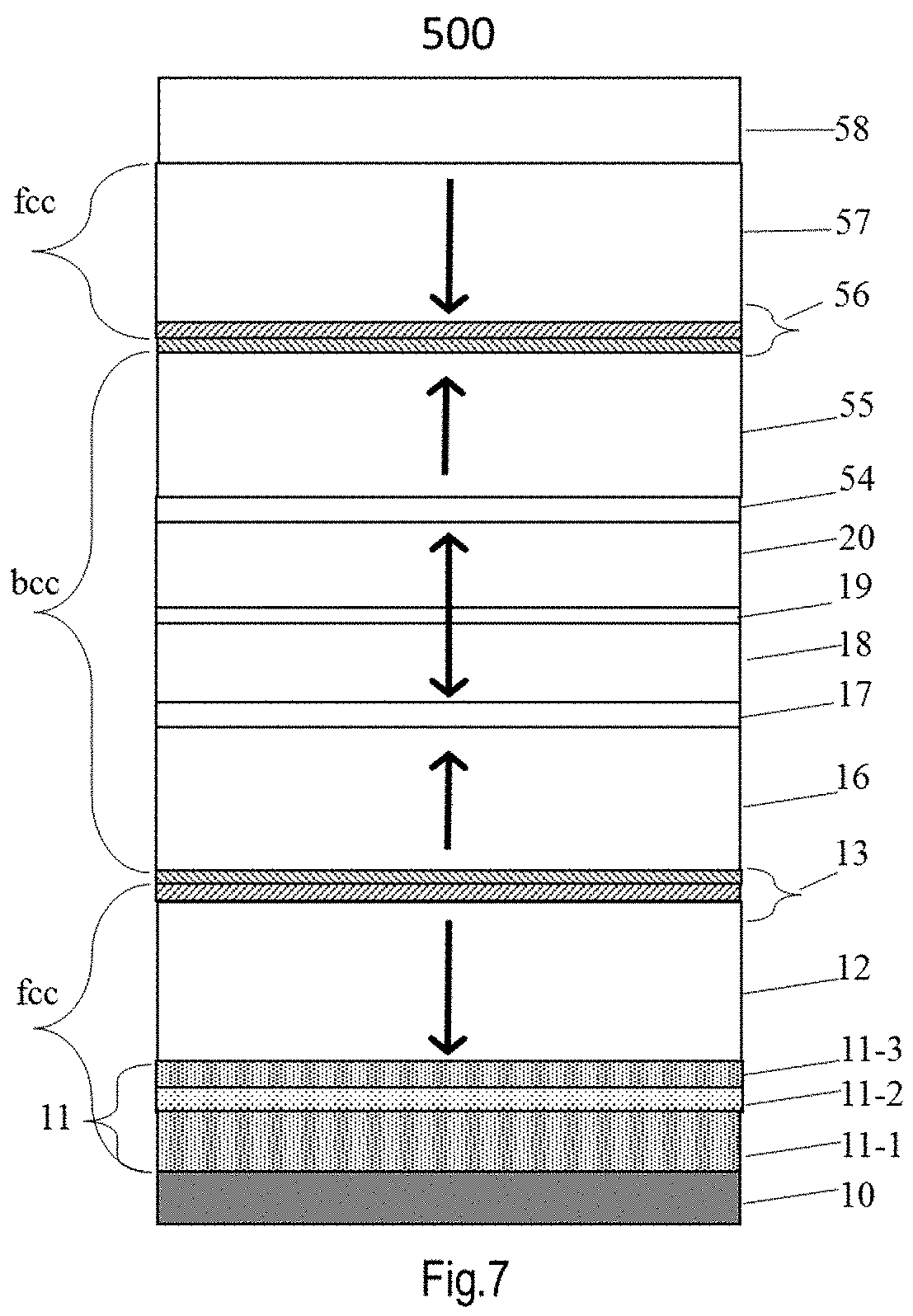Composite seed structure to improve PMA for perpendicular magnetic pinning
a perpendicular magnetic pinning and composite seed technology, applied in the direction of magnetic bodies, spin-exchange-coupled multilayers, substrate/intermediate layers, etc., can solve the problems of making both device design and patterning process difficult for high density memory applications, and achieve enhanced pma, good crystalline transition, and strong anti-ferromagnetic coupling
- Summary
- Abstract
- Description
- Claims
- Application Information
AI Technical Summary
Benefits of technology
Problems solved by technology
Method used
Image
Examples
first embodiment
of a Full pSTT-MTJ Film
[0032]FIG. 4 is a bottom-pinned pSTT-MTJ film (300) with a thick SAF stack. Its layer-by-layer structure sequentially from bottom to top is as follows: a base-layer (10) was first grown on a device substrate (not shown here); followed by a composite seed structure (CSS) (11) comprising ML(11-1) / BL(11-2) / TL(11-3); followed by a thick SAF stack (12 / 13 / 14) of [Co / Pt or Pd]nCo / Ru / Co / [(Pt or Pd) / Co]m in which the thickness of Co is between 0.3 nm and 0.7 nm, the thickness of Pt (or Pd) is between 0.2 nm and 0.8 nm, and the repetition numbers (m>n) are between 2 and 6 for n and between 1 and 4 for m; followed by a crystalline structure transition layer (15) of Ta, W, or Mo with a thickness between 0.1 nm and 0.5 nm; and a magnetic reference layer (16) of CoFeB with a thickness between 0.9 nm and 1.3 nm; a tunnel barrier (17) of MgO between 0.8 nm and 1.2 nm, a magnetic free layer; and a capping stack (21) of MgO(1.0-1.5 nm) / W(1-3 nm) / R (2-5 nm). The magnetic free la...
second embodiment
of a Full pSTT-MTJ Film
[0033]FIG. 5 is a bottom-pinned pSTT-MTJ film (400) with a thin tSAF stack. Its layer-by-layer structure sequentially from bottom to top is: a base-layer (10) was first grown on a device substrate (not shown here); followed by a composite seed structure (CSS) (11) comprising ML(11-1) / BL(11-2) / TL(11-3); followed by a magnetic super-lattice multilayer (12) of [Co / X]n / Co (n is an integer between 2 and 6) in which each Co layer has a thickness between 0.25 and 0.6 nm and each of X is one of Pt, Pd or Ni and has a thickness between 0.2 and 0.4 nm; an alloy AFC layer (13) of RuMo, RhMo, RuW, RhW or CrMo; a reference layer of FeB, FeB / CoFeB or CoFeB; a tunnel barrier MgO (17); a tri-layer recording layer having a first magnetic material layer (18), a non-magnetic Boron absorbing layer (19) of Mo, W or Ta, and a second magnetic material layer (20); a capping layer (21) of MgO / W, MgOFe / W, MgO / Fe / W, MgZnO / W or MgO / W / Ru. In the above stack, the thickness of RuMo, RhMo Ru...
third embodiment
of a Full pSTT-MTJ Film
[0035]FIG. 7 is a dual-pinned pSTT-MRAM (500) with a thin tSAF and a CSS at bottom. A typical structure of stack 500 including base-layer (10) / CSS(11) / [Co / (Pt, Pd or Ni)]n / Co(12) / (Ru / Cr)(13) / Fe / CoFeB (16) / MgO(17) / CoFeB (18) / (W or Mo)(19) / CoFeB (20) / MgO(54) / CoFeB / (55) / Fe / (Cr / (Ru)(56) / Co / [(Pt, Pd or Ni) / Co]n(57) / cap layer (58). During high temperature annealing, said CSS (11) will force the two multi-layers [Co / (Pt, Pd or Ni)]n in contact with from the bottom (12,13) layers and top (56,57) layer to transform into FCC crystalline structure with (111) orientation aligned normal to the film surface and all the middle (16,17,18,19,20,54,55) layers to transform into BCC crystalline structure with (100) orientation, which not only allows to further increase the perpendicular anisotropy (PMA) to the free layer (FL) and thus increase the thermal stability and prolong the retention time of MRAM device, but also allows to increase the thickness of the FL (from 1.8 nm for ...
PUM
| Property | Measurement | Unit |
|---|---|---|
| crystalline lattice constant | aaaaa | aaaaa |
| crystalline lattice constant | aaaaa | aaaaa |
| thickness | aaaaa | aaaaa |
Abstract
Description
Claims
Application Information
 Login to View More
Login to View More - R&D
- Intellectual Property
- Life Sciences
- Materials
- Tech Scout
- Unparalleled Data Quality
- Higher Quality Content
- 60% Fewer Hallucinations
Browse by: Latest US Patents, China's latest patents, Technical Efficacy Thesaurus, Application Domain, Technology Topic, Popular Technical Reports.
© 2025 PatSnap. All rights reserved.Legal|Privacy policy|Modern Slavery Act Transparency Statement|Sitemap|About US| Contact US: help@patsnap.com



